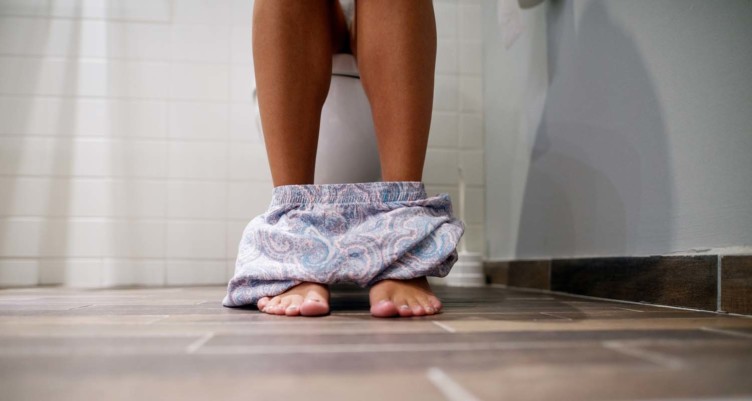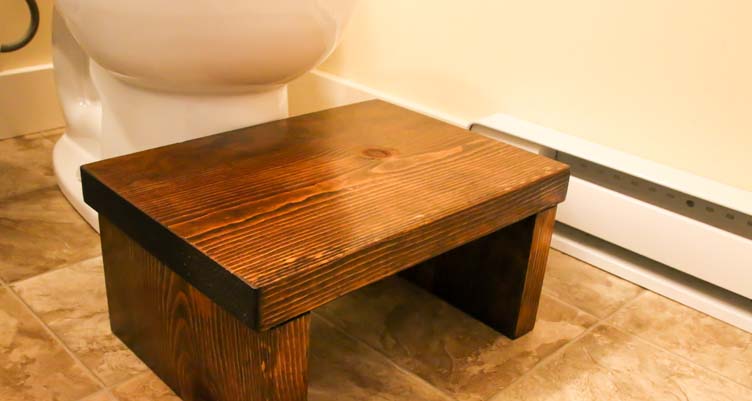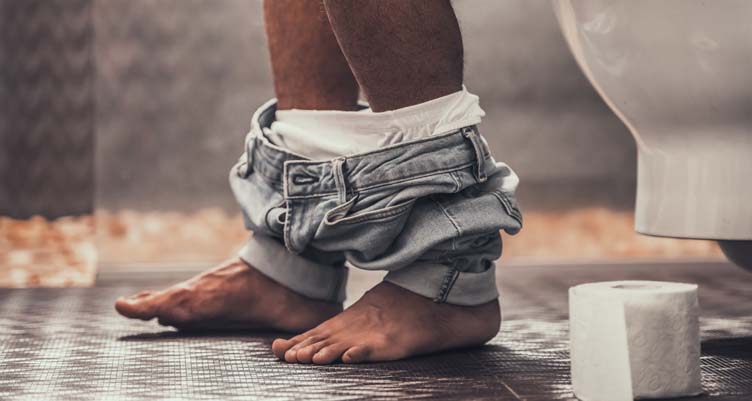Can’t Poop? Science Says the Squatty Potty Helps You Poop Faster and Better

- Can’t poop? Squatting stools like the Squatty Potty promise to help you poop faster and better.
- Squatting stools are raised platforms that elevate your feet while on the toilet. This posture allow your puborectalis muscle to fully relax.
- Research shows the Squatty Potty and other stools do help people defecate faster and with less straining.
Everyone poops. But the Squatty Potty promises to “give you the best poop of your life, guaranteed.”[1] Plopping onto the scene with a successful Shark Tank debut and an unforgettable unicorn-themed commercial, this simple squat stool is breaking down taboos around our daily defecations, sparking odd dinner-time conversations, and helping folks take their sh*t seriously.
With more than 16% of American adults experiencing chronic constipation, and upwards of a billion dollars spent annually on laxatives, it’s no wonder the Squatty Potty has made a splash.[2] Apparently, pooping from a semi-squat position reduces bloating, helps constipation, eases hemorrhoids, and makes pooping better all-around. Squatting stools have gained a cult following, reportedly “changing the lives” of many a standard civilian pooper.
If you frequently can’t poop, you may be wondering if the squatty potty is right for you. If straining, constipation or incomplete bowel movements are part of your regular repertoire, ditch the crossword puzzles and read on to learn more about squat stools, their benefits, and how they may help you achieve a state of high-performance pooping.
What is a squatty potty?
 If we really want to get technical, squatting stools are “defecation postural modification devices,” or DPMDs. In less sterile vernacular, the Squatty Potty is simply a stool that elevates your feet and knees, bringing your body into a semi-squat position even on a standard toilet.
If we really want to get technical, squatting stools are “defecation postural modification devices,” or DPMDs. In less sterile vernacular, the Squatty Potty is simply a stool that elevates your feet and knees, bringing your body into a semi-squat position even on a standard toilet.
While any device that allows you to prop your legs up will do the trick, the Squatty Potty fits discreetly around a standard toilet bowl, providing a more elegant and explainable solution than tucking soup cans or shoeboxes under the loo.
To squat or to sit: pooping postures
 When early man felt nature’s call, it was as simple as finding a safe place to squat. Global history has seen many iterations of toilets, from sitting to squatting, flushing to falling, and private to public. The seated toilet so ubiquitous in today’s western bathrooms was once a privilege only accessible to royal behinds (hence the term “the throne”), but as private-pooping became the social norm in Europe, became a facet of common homes.
When early man felt nature’s call, it was as simple as finding a safe place to squat. Global history has seen many iterations of toilets, from sitting to squatting, flushing to falling, and private to public. The seated toilet so ubiquitous in today’s western bathrooms was once a privilege only accessible to royal behinds (hence the term “the throne”), but as private-pooping became the social norm in Europe, became a facet of common homes.
The built-in, seated, home toilet certainly helped alleviate some of Europe’s sanitary dilemmas, but it may have raised other problems of its own. After discovering that the seated position was linked to many of their own colon issues, Squatty Potty founders Judy and Bobby Edwards set out on a mission to spread the good word of squatting, and revolutionize the way we poop.
How the squatty potty works
 You might be eating like a caveman, but are you pooping like one? While modern health culture has latched on to the idea of returning our diets to their nature-intended roots, what exactly did nature have in mind when that food reached the other end? This raises the anxiety: have we been pooping all wrong?
You might be eating like a caveman, but are you pooping like one? While modern health culture has latched on to the idea of returning our diets to their nature-intended roots, what exactly did nature have in mind when that food reached the other end? This raises the anxiety: have we been pooping all wrong?
It’s all about the ergonomics of your evacuations: As it turns out, humans weren’t really designed to poop from a 90-degree seated angle. A muscle called your puborectalis helps hold things in while you stand by creating a sharp bend in your rectum.[3] This muscle loosens a bit in a seated position, but doesn’t fully relax unless you reach a full squat. Simply put, a seated position cramps your rectum, while a squat creates a straight shot.
Even if a squatting posture promises to flush away your pooping woes, most people won’t be rushing to renovate their bathrooms. By raising your feet, squatting stools put your knees above your hips, basically recreating that primordial experience of squatting over a hole, without ditching your familiar porcelain throne.
A stool makes for better stools… get it?
Squat for science
 While many users are reluctant at first, the squatty potty tends to cultivate a passionate following, and you can hardly bring up the topic without someone (or the entire internet) singing its praise. Proponents of the Squatty Potty claim that their new posture helps them poop faster, easier, and more completely, helping to relieve constipation, hemorrhoids, urinary infections and pelvic floor sensitivity. The evidence may be mainly anecdotal now, but is overwhelming nonetheless.
While many users are reluctant at first, the squatty potty tends to cultivate a passionate following, and you can hardly bring up the topic without someone (or the entire internet) singing its praise. Proponents of the Squatty Potty claim that their new posture helps them poop faster, easier, and more completely, helping to relieve constipation, hemorrhoids, urinary infections and pelvic floor sensitivity. The evidence may be mainly anecdotal now, but is overwhelming nonetheless.
Pooping isn’t science’s most glamorous or profitable sector, and quality, controlled research on the DPMDs and squatting is slim at present. With a study published this month in the Journal of Clinical Gastroenterology, a team at Ohio State University set out to clear the air. In their study, 52 healthy volunteers recorded logs of their movements for 2 weeks without modification, and another 2 weeks using a squat stool. Overall, the participants noted faster poops, less straining, and a more complete emptying using a DPMD.[4]
Benefits of squatting vs. sitting
![pregnant woman in bathroom]() Easier evacuation
Easier evacuation
The design of a squat stool aligns your colon in a happy angle for easier, better pooping. A straighter colon requires less effort and straining to empty.
Hemorrhoids
While pooping posture has not been scientifically linked to hemorrhoids, straining has.[5] So if you’re constantly constipated or can’t poop, there’s a good chance you’ve got Preparation-H at the ready. Squatting stools may assist in preventing or relieving hemorrhoids simply by making it easier to poop. In this study, participants reported significantly less effort needed to fully relieve their bowels in a squatting position, compared to sitting on either a standard or a shortened toilet.[6]
Colon disease and cancer
Sitting and colorectal cancer have not been scientifically linked, although chronic constipation is a risk factor in the development of colon cancers.[7][8] Maintaining a happy, regular flow to eliminate toxins in your crud may help prevent some risks, and a squat stool can help.
UTIs and urinary problems
Having large amounts of poop stuck in your colon can also put pressure on your bladder. This can lead to incomplete emptying, UTIs, and surprise leaks.[9] The angle of the body when squatting may also improve bladder emptying.[10]
Still can’t poop?
A healthy poop starts with a healthy diet. If you’re ready to give a crap, check out these helpful resources to help get things moving in the right direction:
Everything You Need to Know About Probiotics: Probiotics are the good gut bacteria that are normally found in your intestines. A healthy probiotic community is key to healthy digestion and happy poops.
This Poop Chart Tells You Everything You Need to Know About Fixing Your Gut: So, what should your poop look like anyways? Check out this chart to see what your stools are trying to say.
Sign up for early access to sales, product launches, the latest Bulletproof news and more!




 Easier evacuation
Easier evacuation